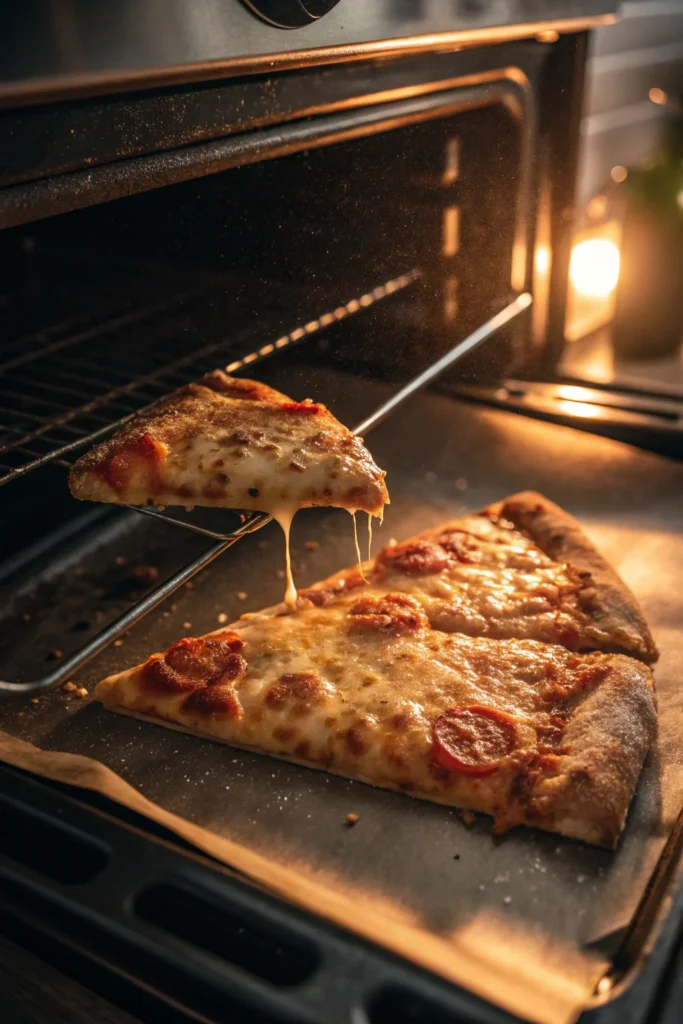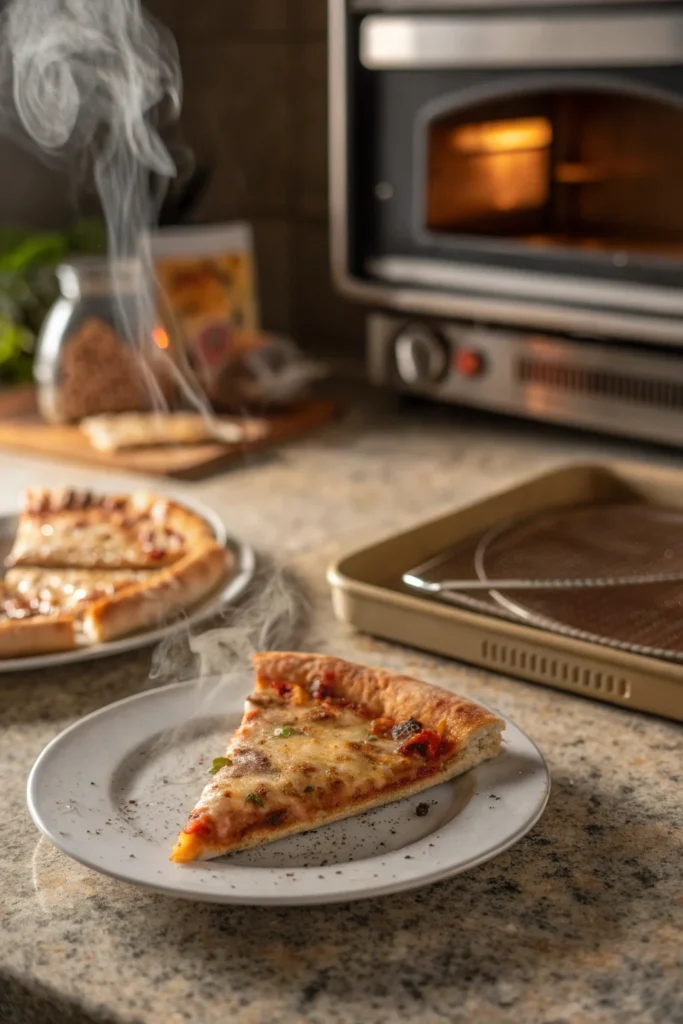How Long Is Pizza Good for in the Fridge? Ever found yourself staring at a leftover pizza box in the fridge, wondering “Is this still safe to eat?” You’re not alone! Pizza is one of the most popular comfort foods, but knowing how long pizza stays good in the fridge can save you from potential food poisoning.
In this guide, we’ll break down everything you need to know about pizza storage. From understanding how long different types of pizza last in the fridge to the best storage practices, freezing techniques, and even proper reheating methods—we’ve got you covered!
I advise you to discover this delicious, tasty and easy dish 10 Inch Pizza
Let’s dive in and make sure your favorite slice stays fresh, delicious, and safe to eat for as long as possible.
Table of Contents
ToggleUnderstanding Pizza Shelf Life
What Affects How Long Pizza Lasts in the Fridge?
Not all pizzas have the same shelf life! Several factors determine whether your leftover slice will stay fresh or turn into a science experiment.
Ingredients and Toppings
The more toppings your pizza has, the faster it can spoil. Meats like pepperoni or sausage can develop bacteria quicker than simple cheese or veggie pizzas.
Sauce Type and Cheese Impact
- Tomato-based sauces generally last longer than creamy or white sauces.
- Cheese-covered pizza can become dry and rubbery over time, affecting taste and texture.
Homemade vs. Store-Bought vs. Restaurant Pizza
- Homemade pizza (without preservatives) usually lasts the shortest time.
- Takeout and restaurant pizza can last longer due to food-grade preservatives.
- Frozen pizza (after being baked) follows different storage rules.
General Guidelines for Refrigerated Pizza
USDA Food Safety Recommendations
According to the USDA, perishable foods like pizza should not be left at room temperature for more than two hours. After that, bacteria can multiply rapidly, making it unsafe to eat.
Average Storage Times for Different Pizza Types
- Plain cheese pizza: 3-4 days
- Meat-heavy pizza: 2-3 days
- Vegetarian pizza: 3-4 days
- Pizza with seafood: 1-2 days
To stay safe, always check for signs of spoilage before eating refrigerated pizza.
How Long Is Pizza Good for in the Fridge?
Refrigeration Timeframes Based on Type
Storing leftover pizza in the fridge is the best way to keep it fresh for a few days. However, not all pizzas last the same amount of time. Factors like ingredients, storage methods, and moisture levels all play a role in determining how long pizza is good for in the fridge.
Freshly Made Pizza
Homemade pizza, especially without preservatives, has a shorter shelf life. If stored properly in an airtight container, it typically lasts 3 to 4 days before the texture and taste start to degrade.
Takeout and Delivery Pizza
Restaurant and takeout pizzas often contain preservatives that extend their shelf life slightly. If refrigerated within two hours after delivery, they can stay good for 3 to 4 days, though some meat-heavy pizzas may spoil faster.
Frozen Pizza After Thawing
Once thawed, frozen pizza behaves similarly to fresh pizza. If refrigerated immediately after baking, it should be eaten within 3 to 4 days for best taste and safety. If left at room temperature for more than 2 hours, bacteria growth increases, making it unsafe to eat.
Signs That Your Refrigerated Pizza Has Gone Bad
Even if your pizza has been in the fridge for only a couple of days, it’s essential to check for signs of spoilage before eating.
Visual Indicators: Mold, Dryness, Discoloration
- Mold growth (green, white, or black spots) is a clear sign your pizza has expired.
- If the crust looks excessively dry and brittle, the pizza has lost too much moisture.
- Discoloration, especially in cheese or toppings, can indicate spoilage.
Smell and Texture Changes
- A sour or rotten smell means bacteria have developed.
- If the cheese feels slimy or the toppings have a mushy texture, the pizza is no longer safe to eat.
When in doubt, throw it out! Eating spoiled pizza can lead to food poisoning, stomach cramps, and nausea.
Proper Storage Tips to Extend Pizza’s Freshness
Want to make your pizza last longer in the fridge? Proper storage methods can help retain freshness and prevent contamination.

Best Ways to Store Leftover Pizza in the Fridge
Proper Wrapping Techniques
The way you store pizza significantly impacts its shelf life. Leaving pizza in the original box might seem convenient, but it’s not the best option for freshness.
Instead, try these methods:
- Airtight Containers – Keeps moisture locked in and prevents odors from seeping in.
- Plastic Wrap or Aluminum Foil – Wrap each slice individually for the best results.
- Resealable Bags – Works well for quick storage and takes up less space.
Using Airtight Containers vs. Plastic Wrap vs. Aluminum Foil
| Storage Method | Pros | Cons |
|---|---|---|
| Airtight Container | Maintains freshness, prevents drying out | Takes up fridge space |
| Plastic Wrap | Quick and easy, retains moisture | Can be messy when unwrapping |
| Aluminum Foil | Blocks light and air, prevents freezer burn | Less effective for moisture retention |
Should You Refrigerate Pizza in the Box?
Many people store leftover pizza in the original cardboard box, but that’s not the best option.
Why Keeping Pizza in the Original Box Is Not Ideal
- Cardboard is not airtight, meaning the pizza can dry out quickly.
- It absorbs moisture, which can make the crust soggy.
- It doesn’t protect the pizza from absorbing other fridge odors.
Better Alternatives for Pizza Storage
- Transfer slices to an airtight container or wrap them individually in plastic wrap or foil.
- If you must use the box, place a sheet of plastic wrap or wax paper between slices to keep them from sticking together.
By storing pizza correctly, you can extend its freshness and enjoy delicious leftovers without worrying about spoilage.
I advise you to discover this delicious, tasty and easy dish Pizza Italia
Can You Freeze Leftover Pizza for Longer Storage?
If you want to extend the life of your leftover pizza beyond a few days, freezing is your best option. Properly stored frozen pizza can remain safe to eat for months while still retaining much of its original flavor and texture.
How to Freeze Pizza Properly
Freezing pizza is simple, but doing it the right way ensures you avoid freezer burn and preserve taste.
Step-by-Step Guide to Freezing Leftover Pizza
- Let the pizza cool – Never freeze hot pizza, as condensation will form and cause sogginess.
- Wrap each slice individually – Use plastic wrap or aluminum foil to protect the pizza from air exposure.
- Use an airtight container or freezer bag – This prevents freezer odors from seeping in.
- Label with the date – Write down when you froze it so you know how long it’s been stored.
- Store flat in the freezer – Avoid stacking to prevent slices from sticking together.
The Best Way to Reheat Frozen Pizza
When you’re ready to enjoy your frozen pizza, reheating it correctly ensures it tastes as close to fresh as possible.
- Oven (Best Method) – Preheat to 375°F (190°C) and bake for 10-15 minutes until crispy.
- Air Fryer – Cook at 350°F (175°C) for 5-7 minutes for a quick and crispy finish.
- Skillet (Quick Fix) – Heat on low with a lid to warm the cheese while keeping the crust crunchy.
- Microwave (Last Resort) – Though fast, this method can make the crust chewy and soggy.
How Long Can Pizza Stay Safe in the Freezer?
Wondering how long pizza is good for in the fridge versus the freezer? While refrigerated pizza lasts 3-4 days, frozen pizza has a much longer shelf life.
Freezing Timeframes for Best Quality
- 1-2 months – Best for retaining fresh flavor and texture.
- Up to 6 months – Still safe to eat, but may lose some quality over time.
Effects of Freezer Burn and How to Prevent It
Freezer burn happens when food is exposed to air, causing dryness and flavor loss. To prevent it:
- Double-wrap slices before freezing.
- Remove as much air as possible from storage bags.
- Use heavy-duty freezer bags instead of thin plastic ones.
Freezing is a great option if you want to store pizza for a longer period without sacrificing too much taste. But once thawed, it should be eaten within 1-2 days for the best experience.
Best Ways to Reheat Refrigerated Pizza

Reheating pizza the right way makes all the difference between a crispy, delicious slice and a soggy disappointment. Here’s how to bring your leftover pizza back to life.
Reheating Methods and Their Effectiveness
Different reheating methods affect the texture and flavor of your pizza. Some work better than others, so choosing the right one can help you enjoy your leftovers as if they were fresh.
Oven vs. Microwave vs. Air Fryer
| Method | Time | Texture Result | Best For |
|---|---|---|---|
| Oven | 10-15 min at 375°F | Crispy crust, melted cheese | Best overall reheating |
| Air Fryer | 5-7 min at 350°F | Crispy and fast | Quick reheating with crunch |
| Skillet | 5 min on low with lid | Crispy bottom, melted top | Single slices |
| Microwave | 1-2 min on high | Soft crust, rubbery texture | Speed over quality |
For the best results, always opt for the oven or air fryer over the microwave!
Common Reheating Mistakes to Avoid
Even if you follow the right reheating method, a few common mistakes can ruin your pizza’s flavor and texture.
Overheating and Drying Out Pizza
Reheating at too high a temperature can burn the crust before the cheese melts. Keeping it under 400°F (200°C) ensures an even reheating process.
Using Incorrect Temperatures
- Too low (under 300°F) results in a soggy crust.
- Too high (above 400°F) dries out the pizza.
- Medium heat (350-375°F) is the sweet spot.
By following these storage and reheating tips, you can enjoy your pizza just as much the second time around!
Health Risks of Eating Expired Pizza
Leftover pizza may look fine after sitting in the fridge for several days, but eating spoiled pizza can lead to foodborne illnesses. Understanding the risks and knowing when to toss your pizza can help prevent unwanted health issues.

What Happens If You Eat Spoiled Pizza?
When pizza sits in the fridge for too long, bacteria begin to grow, making it unsafe to eat. How long is pizza good for in the fridge? Typically, 3-4 days is the safe window, but past that, it becomes a gamble.
Food Poisoning Risks
Consuming expired pizza increases the risk of foodborne illnesses caused by bacteria like:
- Salmonella – Common in meats, cheese, and dairy-based sauces.
- Listeria – Can grow in refrigerated foods, including cheese and deli meats.
- Staphylococcus aureus – Develops when pizza sits at unsafe temperatures.
Symptoms may appear within a few hours to a day and include nausea, vomiting, stomach cramps, and diarrhea.
Common Symptoms of Consuming Bad Pizza
If you accidentally eat spoiled pizza, you may experience:
- Stomach pain or bloating
- Nausea or vomiting
- Fever or chills
- Diarrhea or dehydration
If symptoms are severe, seek medical attention immediately.
How to Safely Handle Leftover Pizza to Avoid Contamination
To keep your pizza safe and fresh, proper food handling is essential.
Proper Food Handling Techniques
- Always refrigerate leftovers within 2 hours of being at room temperature.
- Wash your hands before handling food to prevent cross-contamination.
- Use clean utensils and storage containers to keep bacteria from spreading.
Importance of Consuming Within the Recommended Timeframe
- Eat refrigerated pizza within 3-4 days to minimize food safety risks.
- When in doubt, use the smell and texture test—if it smells bad or feels slimy, toss it!
- If you’re unsure, it’s better to be safe than sorry—don’t take the risk!
By following these guidelines, you can enjoy your pizza safely while avoiding foodborne illness.
Frequently Asked Questions (FAQs)
Still have questions about how long pizza is good for in the fridge? Here are answers to some of the most common questions people ask.
Can You Eat Pizza After 5 Days in the Fridge?
Most food safety experts, including the USDA, recommend eating refrigerated pizza within 3-4 days. After 5 days, bacteria growth increases, making it unsafe to eat—even if it looks fine.
Is It Safe to Eat Cold Pizza Without Reheating?
Yes, as long as the pizza was stored properly in the fridge and hasn’t passed the 4-day mark. Cold pizza is safe to eat, but reheating enhances the flavor and texture.
How Long Does Vegan or Gluten-Free Pizza Last in the Fridge?
Vegan pizza (without dairy or meat) can last 4-5 days, but toppings like fresh veggies may spoil sooner.
Gluten-free pizza follows the same rules as regular pizza—about 3-4 days in the fridge.
Does the Type of Toppings Affect How Long Pizza Lasts?
Yes! Some toppings spoil faster than others:
Meat-heavy pizzas (pepperoni, sausage, chicken) last 2-3 days due to bacteria growth.
Cheese-only pizzas stay good for about 3-4 days.
Vegetable pizzas can become soggy quickly but last 3-4 days if stored properly.
What’s the Best Way to Tell If Pizza Is Still Good to Eat?
heck for these warning signs:
Mold growth or discoloration
A sour or rotten smell
A slimy or dried-out texture
If you notice any of these, discard the pizza immediately.
Can You Refreeze Pizza After Thawing It Once?
Technically, yes, but the texture and flavor will suffer. If you must refreeze, make sure it hasn’t been left at room temperature for more than 2 hours and store it properly in an airtight container.
Conclusion
Key Takeaways on How Long Pizza Is Good for in the Fridge
After exploring the best storage methods, freezing options, and reheating techniques, it’s clear that keeping pizza fresh requires proper handling. But the most important question remains—how long is pizza good for in the fridge?
- Refrigerated pizza lasts 3-4 days if stored correctly.
- Freezing extends pizza’s life up to 2 months while maintaining decent quality.
- Proper storage using airtight containers, plastic wrap, or foil keeps pizza from drying out.
- Reheating in an oven or air fryer helps restore the best taste and texture.
Final Thoughts on Reducing Food Waste and Staying Safe
Throwing out leftover pizza is disappointing, but eating spoiled pizza can be dangerous. To minimize waste:
- Store pizza properly right after your meal.
- Freeze extra slices if you know you won’t eat them within a few days.
- Reheat pizza the right way to keep it enjoyable.
If you’re ever unsure whether pizza is still safe to eat, follow the golden rule: when in doubt, throw it out!
Additional Tips for Keeping Pizza Fresh Longer
Should You Store Pizza in the Fridge or at Room Temperature?
Leaving pizza out for too long increases the risk of bacteria growth. According to food safety experts:
- At room temperature, pizza should not sit out for more than 2 hours.
- In the fridge, it remains safe for 3-4 days.
- Frozen pizza lasts up to 2 months if stored properly.
How to Keep Pizza from Getting Soggy in Storage
Nobody likes soggy leftovers. To prevent this issue:
- Use paper towels between slices to absorb moisture.
- Avoid stacking slices directly on top of each other without a barrier.
- Reheat pizza in an oven instead of a microwave to crisp it up.
How to Reheat Pizza Without Drying It Out
The best way to bring refrigerated pizza back to life is by using the right reheating method.
- Oven at 375°F (190°C) for 10-15 minutes gives the best results.
- Air fryer at 350°F (175°C) for 5-7 minutes makes it crispy and fast.
- A skillet with a lid on low heat warms the pizza evenly.
- Microwaving with a cup of water helps prevent a rubbery texture.
By following these simple tips, you can enjoy fresh, delicious pizza even days after your meal!









